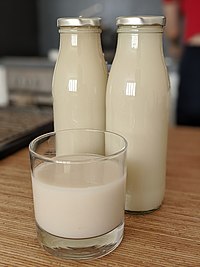
Photo from wikipedia
(1) Background: With the increase in people’s consumption of processed oat products, the production of selenium (Se)-enriched oat has become a possibility to supplement the human body with Se. Therefore,… Click to show full abstract
(1) Background: With the increase in people’s consumption of processed oat products, the production of selenium (Se)-enriched oat has become a possibility to supplement the human body with Se. Therefore, the effects of various factors on the Se-enriched ability and yield of different oat varieties were comprehensively studied. (2) Methods: cv.“Pinyan 5” and cv.“Bayou 18” were applied at the stem-elongation stage and heading stage in the Jinzhong (JZ), and cv.“Bayou 1” and cv.“Jinyan 18” were applied at the heading stage and flowering stage in the northwestern Shanxi (JXB) with different doses of Na2SeO3 (0, 5.48, 10.96, 21.92, 43.84, 65.76, 98.64, 0, 5.48, 10.96, 21.92, 43.84, 65.76, 98.64, 147.96 g hm−2) by soil application and foliar spraying. (3) Results: The grain Se content and yield of oat were affected by the variety, Se application dose, stage and method of Se supplementation. Additionally, the Se content in oat grain was positively correlated with the Se application dose while the yield of oat first increased and then decreased with the Se application dose. (4) Conclusions: In the JZ and JXB, 21.92 g hm−2 and 43.84 g hm−2 Se was sprayed on the leaves of cv.“Bayou 18” and cv.“Bayou 1” at the heading stage, respectively, was the most effective Se biofortification program.
Journal Title: Plants
Year Published: 2022
Link to full text (if available)
Share on Social Media: Sign Up to like & get
recommendations!